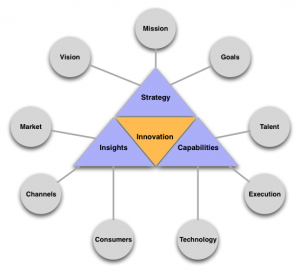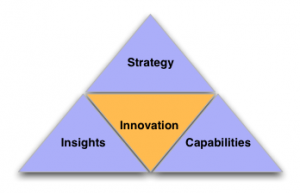Innovation Models
Truly successful innovation is never easy to accomplish. As much as the myths of innovation and fables of inventors have lead us all to to believe that creativity arrives with a brilliant flash of inspiration, the reality is that the successful innovative products and services we see are the culminating result of tremendously hard work, a great deal of failure, and endless iteration. The most successful innovative products are often heralded for their most obvious innovative surface characteristics as well; such as their industrial design or unique interaction models. Unfortunately, this simplifies what is really happening with these breakthrough products that is enabling their amazing success in the market and their resilient defense against the competition. These successful organizations are not simply innovating along one or two dimensions with such products and services. They have intentionally created compound innovation models to evolve and disrupt the existing experience ecosystem along multiple dimensions simultaneously.
To compete in today’s competitive marketplace with its accelerating rate of change and disruption, an organization must be capable of creating a robust model for forging compound innovation. First, a sustainable and successful innovation process must exist at the intersection of Strategy, Insights, and Capabilities.
Unguided, freeform innovation can certainly yield interesting discoveries and this may indeed be an appropriate approach for university researchers and well-funded R&D organizations. But, business organizations can rarely afford the investment in innovation programs that may never yield a return. To greatly increase your chances of success, innovation must be guided by business and product strategy, inspired by customer insights and marketplace opportunities, and grounded in technology and talent capabilities to ensure execution success.
Next, you must develop a compound model of innovation that identifies the multiple dimensions along which innovation can be created in order to ultimately forge a successfully innovative product and/or service that dominates the market. It is very difficult for a competitor to unseat you when you have multiple layers of innovation like this.
 Apple’s amazing success with the iPod, iPhone, and iPad is a tribute to this compound model of innovation. Those products would not be the market leaders that they are today if they were simply innovating along one or two dimensions, such as the industrial design of the device or the features of the iOS software. Carefully examine what Apple accomplished and you will see that they brought multiple dimensions of innovations together to dramatically shake up the market. To name just a few:
Apple’s amazing success with the iPod, iPhone, and iPad is a tribute to this compound model of innovation. Those products would not be the market leaders that they are today if they were simply innovating along one or two dimensions, such as the industrial design of the device or the features of the iOS software. Carefully examine what Apple accomplished and you will see that they brought multiple dimensions of innovations together to dramatically shake up the market. To name just a few:
- Technological innovation in the hardware (e.g., Retina display) and software (e.g., App Store)
- Visual design and interaction design innovation (e.g., touchscreen gestures)
- Channel innovation (e.g., a unique agreement with music companies, beautiful Apple Store experiences)
- Business strategy innovation (e.g., song pricing, AT&T partnership)
- Insights innovation (e.g., huge amounts of mobile data flowing back from consumers)
- Brand and marketing innovation (e.g., aspirational brand experiences that lead people to wait in line for days for new product launches)
Now, does every innovation along every single dimension need to be an earth-shattering disruptive force? No, not at all. But, if you do this well enough, the fact that you are delivering synergistic innovations means that it is all the more difficult for a competitor to attack you along just one or two dimensions. Many, many competitors continue to attack Apple’s products by creating MP3 players with more features at a lower price, tablets with more open software at a lower price, smartphones that replicate touchscreen experiences in a sexy industrial design. What they have been unable to replicate is the holistic product and service experience ecosystem that Apple created with its compound innovation model.
You can begin this process today to assess your own organization’s level of excellence and innovation capabilities for each of these dimensions, relative to your competitors. Some examples of questions you should be asking and be able to answer:
- Vision: Who do you want to be?
- Mission: What is your purpose?
- Goals: What problem are you going to solve or what new opportunity are you creating?
- Strategy: How can you do it better than anyone else?
- Talent: Have you hired the right people and are you organized for success?
- Technology: What is possible?
- Execution: Are your processes helping or hurting your ability to innovate and execute?
- Capabilities: What can you create and deliver?
- Consumers: Who are they and what are their unmet wants and needs?
- Channels: Are there new and better ways to reach customers and partners?
- Market: Can you stop “chasing the puck” and instead envision where the industry is heading?
- Insights: What do you know that is helping you identify new opportunities?


[…] by admin • on September 29, 2011 • in Innovation, Process, Strategy var addthis_product = 'wpp-262'; var addthis_config = {"data_track_clickback":true};var addthis_options = "facebook,twitter,linkedin,google_plusone,tumblr,stumbleupon,digg,email,print";I moderated a great panel discussion on Sustainable Innovation yesterday on Focus. It was quite enlightening to hear insights from people who’ve been at larger companies like Facebook, Linkedin, eBay, and Yahoo; but have also been at smaller startups too. I raised the concept of “Compound Innovation” and wrote up some of my thoughts on why I think this is a very powerful model of innovation here. […]
[…] Innovation at intersection of Strategy, Insights, and Capabilities Image by Brilliant Forge A sustainable and successful innovation process must exist at the intersection of Strategy, Insights, and Capabilities. Read more at: Compound Innovation Models […]